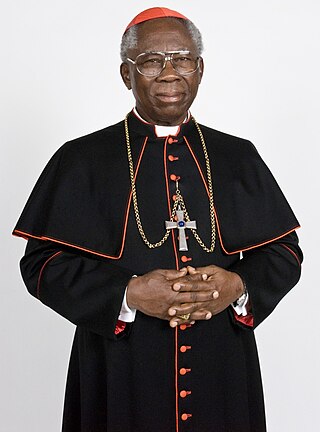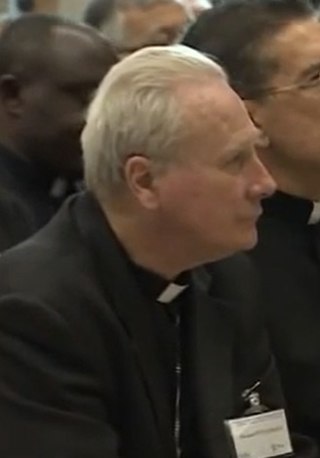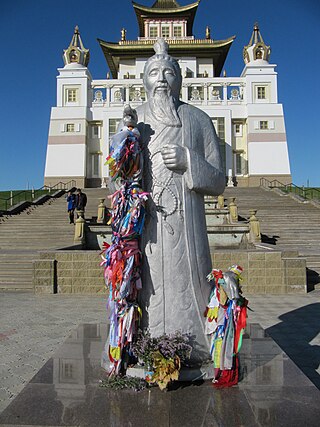
Bon or Bön, also known as Yungdrung Bon, is the indigenous Tibetan religion which shares many similarities and influences with Tibetan Buddhism. It initially developed in the tenth and eleventh centuries but retains elements from earlier Tibetan religious traditions. Bon is a significant minority religion in Tibet, especially in the east, as well as in the surrounding Himalayan regions.

Interfaith dialogue refers to cooperative, constructive, and positive interaction between people of different religious traditions and/or spiritual or humanistic beliefs, at both the individual and institutional levels.

Francis Arinze is a Nigerian cardinal of the Catholic Church. He was Prefect of the Congregation for Divine Worship and the Discipline of the Sacraments from 2002 to 2008 and before that led the Secretariat for Non-Christians from 1984 to 2002.

Jetsun Milarepa was a Tibetan siddha, who was famously known as a murderer when he was a young man, before turning to Buddhism and becoming a highly accomplished Buddhist disciple. He is generally considered one of Tibet's most famous yogis and spiritual poets, whose teachings are known among several schools of Tibetan Buddhism. He was a student of Marpa Lotsawa, and a major figure in the history of the Kagyu school of Tibetan Buddhism. He is also famous for the feat of climbing Mount Kailash.

Marpa Lotsāwa, sometimes known fully as Marpa Chökyi Lodrö or commonly as Marpa the Translator, was a Tibetan Buddhist teacher credited with the transmission of many Vajrayana teachings from India, including the teachings and lineages of Mahamudra. Due to this, the Kagyu lineage, which he founded, is often called Marpa Kagyu in his honour.
The Dicastery for Interreligious Dialogue, previously named Pontifical Council for Interreligious Dialogue (PCID), is a dicastery of the Roman Curia, erected by Pope Paul VI on 19 May 1964 as the Secretariat for Non-Christians, and renamed by Pope John Paul II on 28 June 1988.

Jean-Louis Pierre Tauran was a French cardinal of the Catholic Church. When he died, he had been the president of the Pontifical Council for Interreligious Dialogue since 2007 and Camerlengo of the Holy Roman Church since the end of 2014. He was made a cardinal in 2003 and was the Cardinal Protodeacon from 2011 to 2014. His earlier career included almost thirty years in the diplomatic service of the Holy See and several years as the Vatican's chief archivist and librarian.

Sergio Pignedoli was a prominent Italian Cardinal of the Roman Catholic Church and a top candidate for pope. He served as auxiliary bishop to Pope Paul VI when he was archbishop of Milan, and as President of the Secretariat for Non-Christians from 1973 to 1980. He was elevated to the cardinalate in 1973.

There were links between Buddhism and the pre-Christian Mediterranean world, with Buddhist missionaries sent by Emperor Ashoka of India to Syria, Egypt and Greece from 250 BC. Significant differences between the two religions include monotheism in Christianity and Buddhism's orientation towards nontheism which runs counter to teachings about God in Christianity, and grace in Christianity against the rejection of interference with karma in Theravada Buddhism on.

Michael Louis Fitzgerald is a British cardinal of the Roman Catholic Church and an expert on Christian–Muslim relations. He has had the rank of archbishop since 2002. At his retirement in 2012, he was the apostolic nuncio to Egypt and delegate to the Arab League. He headed the Pontifical Council for Interreligious Dialogue from 2002 to 2006. Pope Francis raised him to the rank of cardinal on 5 October 2019.

Paul Francis Knitter is an American theologian. He is currently an emeritus professor at Union Theological Seminary, where he has served as the Paul Tillich Professor of Theology, World Religions and Culture since 2007. He is also Emeritus Professor of Theology at Xavier University in Cincinnati, where he taught for 28 years before moving to Union. Knitter is known for his work on religious pluralism and multiple religious belonging, particularly regarding Buddhism and Christianity.
Roberto Rino Magliola is an Italian-American academic specializing in European hermeneutics and deconstruction, comparative philosophy, and inter-religious dialogue. He is retired from the National Taiwan University and Assumption University of Thailand.
Mario Ignacio Aguilar is the Chair of Religion and Politics at the School of Divinity of the University of St Andrews, Scotland.
Buddhist-Christian Studies is an academic journal covering the historical and contemporary interrelationships between Buddhism and Christianity. It includes articles, conference reports, book reviews, and sections on comparative methodology and historical comparisons, as well as ongoing discussions from two dialogue conferences: the Theological Encounter with Buddhism, and the Japan Society for Buddhist–Christian Studies. Since 1987 it has served as the official journal of the Society for Buddhist-Christian Studies, a member of the Council of Societies for the Study of Religion.

The main religion in Tibet has been Buddhism since its outspread in the 8th century AD. As of 2022 the historical region of Tibet is mostly comprised in the Tibet Autonomous Region (TAR) of China and partly in the Chinese provinces of Qinghai and Sichuan. Before the arrival of Buddhism, the main religion among Tibetans was an indigenous shamanic and animistic religion, Bon, which would later influence the formation of Tibetan Buddhism and still attracts the allegiance of a sizeable minority of Tibetans.
Divine madness, also known as theia mania and crazy wisdom, refers to unconventional, outrageous, unexpected, or unpredictable behavior linked to religious or spiritual pursuits. Examples of divine madness can be found in Buddhism, Christianity, Hellenism, Hinduism, Islam, Judaism and Shamanism.

Tsagaan Ubgen is the Mongolian guardian of life and longevity, one of the symbols of fertility and prosperity in the Buddhist pantheon. He is worshiped as a deity in what scholars have called "white shamanism", a subdivision of what scholars have called "Buryat yellow shamanism"—that is, a tradition of shamanism that "incorporate[s] Buddhist rituals and beliefs" and is influenced specifically by Tibetan Buddhism. Sagaan Ubgen originated in Mongolia.
Buddhists, predominantly from India, first actively disseminated their practices in Tibet from the 6th to the 9th centuries CE. During the Era of Fragmentation, Buddhism waned in Tibet, only to rise again in the 11th century. With the Mongol invasion of Tibet and the establishment of the Mongol Yuan dynasty (1271–1368) in China, Tibetan Buddhism spread beyond Tibet to Mongolia and China. From the 14th to the 20th centuries, Tibetan Buddhism was patronized by the Chinese Ming dynasty (1368–1644) and the Manchurian Qing dynasty (1644–1912) which ruled China.
John Powers is American born Professor of Asian Studies and Buddhism. Much of his teaching career was at the Australian National University in Canberra.
Leo Dennis Lefebure is an American Roman Catholic priest of the Archdiocese of Chicago, university professor, and author. He is the inaugural Matteo Ricci S. J. Chair of Theology at Georgetown University. He is vice president of the American Theological Society, and president-elect, with his term as president beginning in 2025.













